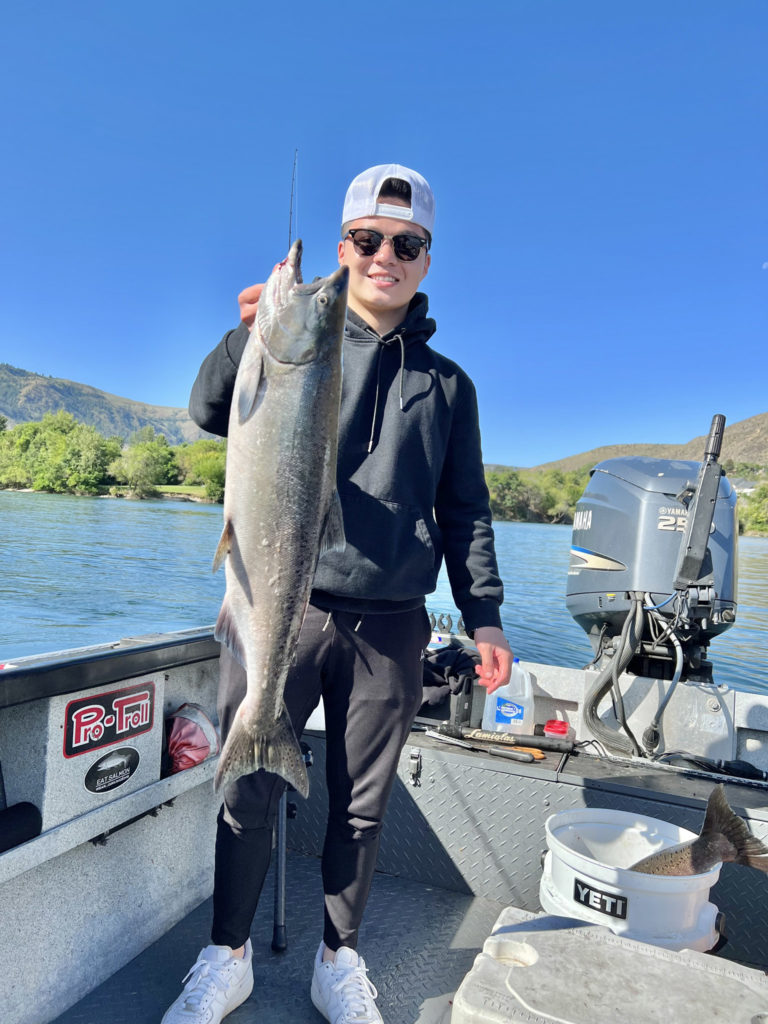
It appears 2023 is starting off on a positive note for salmon anglers! Back in December, the Washington Department of Fish and Wildlife (WDFW) released Columbia River salmon forecasts that could point to blissful sport fishing opportunities. The 2023 Columbia spring Chinook forecast is 307,800; a jump from the 197,000 forecast and an actual return of 274,495 in 2022; and 143,200 and 152,675 respectively in 2021.
If the prediction pans out, the 2023 return could be the largest spring Chinook return dating back to 2015 and is comparable to average returns from 2010 to 2014. A good number of Columbia salmon returns have been trending upward the past couple of years due to better ocean conditions, good outmigration, and no issues related to droughts, floods, or elevated water temperatures. WDFW fishery managers agree that it could be one of the best fishing seasons seen in a while.
Columbia spring Chinook are the first migrating salmon to arrive in Washington waterways from January through June, with numbers peaking March through mid-April. Their spawning time frame in tributaries occurs from August through October. While the first official day of spring is still a month or so away (March 20 to be exact), usually the first spring Chinook is caught by a lucky angler in January or early February in the Lower Columbia mainstem, Oregon’s Multnomah Channel, or the Lower Willamette. This early winter fishery on the Lower Columbia (open daily through March 31 from Buoy 10 to the I-5 Bridge) creates mass hysteria right after the New Year as anglers suffering from a bout of “winter blues” hit the water for a chance at catching the first spring Chinook.
On the Washington side of the Lower Columbia, tributaries like the Kalama are expecting a spring Chinook forecast of 2,400, on par to the recent 10-year average. The Cowlitz River is forecasted at a strong 9,000, while the Lewis is 4,700, and on the Oregon side, the Willamette River spring Chinook forecast is a whopping 71,000. Spring Chinook forecasts to tributaries above Bonneville Dam include 4,400 for Wind River; Drano Lake is 8,000; and the Klickitat is 1,400. As in past seasons, additional in-season meetings from March through May will provide updates on actual fish returns and ongoing fisheries as they become available, with a chance of extending seasons if the run appears larger than expected.
More Promising Salmon Forecasts
The early summer salmon fishery along the Upper Columbia from Wenatchee to Brewster has seen decent catches of fish the past several years. The 2023 Upper Columbia summer Chinook forecast is 84,800, up from a forecast of 56,300 and an actual return of 78,444 in 2022.
The summer Chinook fishery opened July 1 in 2022 and July is usually the best fishing period. Anglers track when it’s time to go fishing by monitoring dam counts along the Columbia. Anglers could possibly see more sockeye fishing success in the Upper Columbia with a forecast of 234,500 in 2023. The actual sockeye run in 2022 hit 664,935 (198,700 was the forecast) and was the largest run since Bonneville Dam was constructed in 1938. It also waxed the 2020 return of 345,018. The driver for the sport fisheries is an Okanogan sockeye salmon run forecast of 187,400 (175,700 was forecast with an actual return of 513,317 in 2022). The Lake Wenatchee sockeye salmon forecast of 44,300 is well above the 23,000 spawning escapement goal. If that occurs, look for a great late-summer sport fishery in the lake.
WDFW also provided some early information for the 2023 Columbia fall adult Chinook outlook that is equivalent to the 2022 return. The fall forecast in 2022 was 485,500 and the preliminary adult return is about 137 percent of that forecast. The preliminary Bonneville Pool Hatchery adult Chinook return in 2022 appears to be the highest return since 1964. Other fall Chinook stocks should also see a slight uptick.
The 2023 Columbia coho forecast hasn’t been released just yet, but the preliminary return in 2022 was about 70 percent of the 683,700 forecast. The 2022 preliminary coho jack return appears to be less than the 2021 return of approximately 63,700.
The tentative date for the WDFW salmon forecast meeting is March 3 with a location to be determined. This meeting will provide forecasts for Chinook, coho, sockeye, chum, and pinks.
The Pacific Fishery Management Council (PFMC) meeting March 5-10 is where 2023 ocean fishing options will be adopted. Two tentative WDFW public meetings in March will shape fisheries for inner-marine and freshwater salmon fisheries, and the final salmon seasons will be adopted after additional meetings in April.